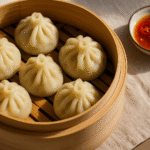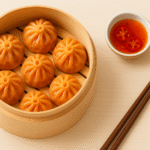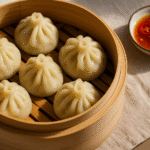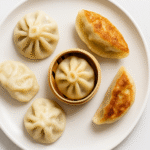It’s a quiet revolution — one that’s happening not in paddocks, but in petri dishes.
In 2025, Australia became one of the first countries in the world to approve the sale of lab-grown meat, starting with cultured quail produced by the Sydney-based food tech company Vow.
That single decision could redefine how we think about meat — and how we make dumplings.
Because if dumplings have always been little packages of cultural memory, what happens when the filling no longer comes from a farm, but from a lab?
The Birth of Cultured Meat
Cultured meat (also called cell-based or lab-grown meat) is created by taking a small sample of animal cells and growing them in controlled conditions.
No slaughter, no antibiotics — just cell growth nurtured in nutrient-rich bioreactors.
The result? Real meat, biologically identical to what comes from animals, but with a fraction of the environmental footprint.
The idea has long been debated — is it ethical, safe, or even appetizing? — but with Australia’s green light, it’s no longer hypothetical.
And in this brave new world of culinary innovation, dumplings may be the perfect place to start.
Why Dumplings Are the Ideal Gateway Food
Dumplings have always been adaptable. They absorb cultures, ingredients, and stories from everywhere.
From Chinese jiaozi to Italian tortellini, they’re the original fusion food — and that makes them the perfect vessel for food innovation.
Cultured meat fits right into that lineage.
Their small size, versatile seasoning, and mix of textures allow home cooks and chefs to experiment without risk.
If you’re hesitant to try lab-grown meat, a dumpling’s dough wrapper and flavorful sauce can make the first bite feel familiar — even comforting.
In a sense, dumplings are the diplomacy food of the future — bridging tradition and technology, skepticism and curiosity.
What They Could Taste Like
When Vow unveiled its first cultured quail prototype, early tasters described it as tender, slightly gamier than chicken, with a clean aftertaste.
That kind of flavor lends itself perfectly to dumpling fillings that mix protein with herbs, aromatics, and vegetables.
Imagine these possible creations in the near future:
- Cultured Quail and Leek Dumplings — a refined, game-forward take on a northern Chinese classic.
- Hybrid Pork and Cultured Meat Dumplings — balancing nostalgia with sustainability.
- “Future Gyoza” — a pan-fried blend of lab-grown chicken, miso, and shallots.
Each one retains the comfort of the familiar but introduces an entirely new culinary conversation.
The Sustainability Equation
Behind the novelty is a serious goal: reducing the climate impact of meat.
Traditional livestock farming is responsible for nearly 15% of global greenhouse gas emissions.
Cultured meat could cut that dramatically by eliminating deforestation, reducing water use, and minimizing methane emissions.
For food lovers who value sustainability, that matters.
At Dumplings & Co, we’ve already explored plant-based approaches in The Rise of Plant-Based Dumplings: Delicious, Sustainable, and Healthy.
Cultured meat takes that next step — keeping the flavor of meat while removing the environmental cost.
If successful, this shift could help redefine sustainable comfort food for a new generation.
The Roadblocks Ahead
Of course, not everyone’s ready to embrace it.
Consumers still question whether lab-grown meat is truly “natural,” and regulatory frameworks remain complex.
Costs, too, are a major factor — cultured meat currently costs far more to produce than traditional protein.
But the trend is clear.
As technology scales and prices fall, cultured meat will move from headlines to supermarkets, then to kitchens.
In that transition, dumplings could serve as the entry point — a way to introduce consumers gently to a world of ethical, lab-created protein.
The Australian Edge
Australia’s multicultural food scene makes it an ideal testing ground for food tech innovation.
Imagine Melbourne pop-ups serving cultured duck siu mai or Sydney restaurants offering sustainable quail gyoza as part of a “Future Feast” tasting menu.
The nation’s openness to fusion and sustainability gives it a natural advantage — it can lead in culinary storytelling, not just scientific advancement.
In time, “made in Australia” could mean not only high quality, but high ethics.
What It Means for Home Cooks
Right now, cultured meat isn’t available to consumers — only select chefs and research labs are experimenting with it.
But when it reaches supermarkets, the way we cook dumplings at home could shift dramatically.
Imagine choosing between plant-based, farm-raised, and lab-grown protein in the freezer aisle — each with its own story, texture, and purpose.
You’ll be able to fold sustainability into your meals, literally.
Until then, home cooks can prepare by experimenting with hybrid recipes — blending traditional meat with lentils, mushrooms, or tofu to mimic the texture and environmental benefits of cultured meat dumplings.
A New Chapter for Dumplings
Food evolves because people do.
The dumpling, once a symbol of simplicity, now stands at the frontier of food science — a small, familiar form carrying the weight of enormous change.
If dumplings represent comfort, perhaps the future they’re entering represents comfort with innovation — a willingness to fold hope and technology into something delicious.
The next bite might not come from the past, but it might still feel like home.










